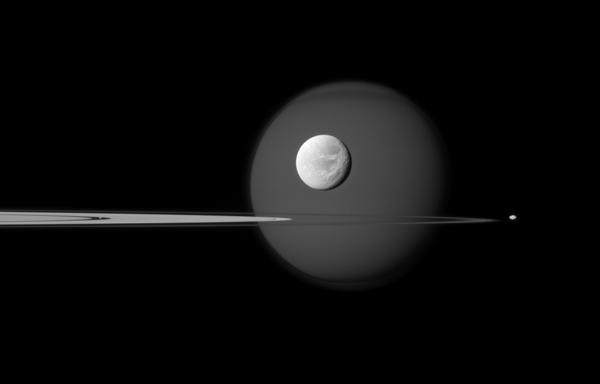View the video
Saturn’s skies sparkle with the faces of its many moons — some frosted and bright, others darker, honeycombed, or hiding beneath haze. How nature built these worlds from the same set of materials is a conundrum that has eluded scientists for years.

Now, a team suggests that violence early in the solar system’s history produced the many strange moons that rise over Saturn’s ringed horizons.
Giant collisions between an extinct population of much larger Saturnian moons could have ultimately produced Titan — the largest of Saturn’s satellites — and spat out a half-dozen midsize moons, says planetary scientist Erik Asphaug of the University of California, Santa Cruz. He presented the theory October 19 at the American Astronomical Society’s Division for Planetary Sciences meeting in Reno, Nev.
“Explaining this diverse grab bag of satellites that presumably had a common origin around Saturn is very challenging,” Asphaug says. ”Collisions are a great way of explaining heterogeneity in the system.”
Saturn’s moons — 62 confirmed so far — come in a variety of sizes, ranging from tiny moonlets that live inside the planet’s iconic rings, to Titan, which holds 96 percent of Saturn’s moon mass. Between those extremes is a smattering of midsized, icy moons. The family includes some of the system’s most photogenic members, such as two-toned Iapetus, saltwater-spitting Enceladus and honeycombed Hyperion.
Some of these middleweight worlds are mostly rocky, others mostly icy. Some, like Enceladus, are geologically active. Others, like Rhea and Iapetus, even show evidence for once having rings or subsatellites of their own.
Saturn’s larger neighbor Jupiter doesn’t have such midsized moons. Instead, four large satellites (Ganymede, Callisto, Io and Europa) dominate the Jovian system, which is otherwise full of tiny moons less than 100 kilometers across. Asphaug and his collaborator, Andreas Reufer of the University of Bern in Switzerland, simulated an early version of Saturn with an orbiting menagerie that looked more like present-day Jupiter’s. Instead of a Titan, several large moons spun around the young planet.
But not for long.
Soon after the system’s birth — perhaps due to a marauding ice giant planet, or migration of the satellites themselves — the infant moons spasmed in their orbits, veered off course and collided with one another. The collisions simultaneously stripped the impacting bodies of their icy, rocky outer layers, leaving their cores to merge. Eventually, those cores became Titan. Material flung from the collisions coalesced into the midsize moons, a simple way to explain the diversity observed today. The story also explains Titan’s elongated orbit, another conundrum that has puzzled scientists.
Asphaug points out that there are still some important unresolved issues, including how the midsize moons would survive being swept up during Titan’s accretion.
Another issue, says planetary scientist William McKinnon of Washington University in St. Louis, is how to get the moons where they are. Some, like Iapetus, are very, very far from Saturn.
McKinnon notes that there are several other theories describing early Saturnian, moon-making dramas. One involves a second large, young satellite, an unfortunate infant that wandered too close to Saturn and was shredded, leaving behind bits of material that then clumped into midsize moons. Another suggests the medium moons grew from the planet’s rings themselves — though no one has really been able to make that one work.
The clues come from the moons themselves.
“If we can figure out what icy satellites are made out of, that places strong constraints on how they formed,” says Joseph O’Rourke of Caltech.
Recently, O’Rourke considered how Titan may be put together. Gravity data returned from NASA’s Cassini spacecraft suggest that Titan is only partially differentiated — it lacks discrete core, mantle and crust layers. But heat circulating inside Titan would make an undifferentiated ice-and-rock interior unstable over billions of years, O’Rourke and planetary scientist David Stevenson of Caltech, report in a paper posted online October 21 at arXiv.org. Such an ice-rock mix, O’Rourke says, requires formation from a cool, slowly coalescing mix of gas and dust — not a chaotic, collision-riddled environment. If Titan is differentiated, as O’Rourke’s calculations suggest, then its interior may not be a salt-and-pepper mix of rock and ice.
“Once things get too warm for the rock and ice to stay together, the rock will begin to sink toward the center,” says planetary scientist Jonathan Lunine of Cornell University. In 2010, Lunine proposed a different type of interior consisting of a large amount of puffy, hydrated silicate near the moon’s center. Building Titan with that type of material would occur more favorably if the satellite formed quickly in a warmer environment where ice could melt and hydrate the silicates.
“If we had X-ray vision and could see [Titan] was not completely separated, we would know something very profound about how hot it got when it was young,” McKinnon says. “If it’s completely separated, all we know is that at some time during the last 4.5 billion years, it got hot enough to separate.”
Two Galilean satellites, adding up to about the mass of Titan, colliding at low initial relative velocity and an impact angle of 75°. They are coded by color, with 50 wt% ice, over 35 wt% rock, over 15 wt% iron. The outcome is a merger, spinning off spiral arms that clump into icy bodies ~100 to ~1000 km diameter. Some of these clumps escape, becoming moons of their own; others remain bound to the final merged body, becoming subsatellites at least for some time.







